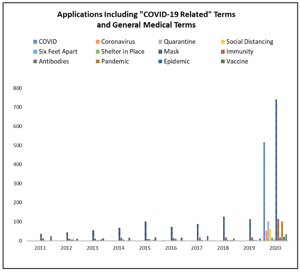A timely empirical study conducted by Professor Irene Calboli examines the unprecedented amount of trademark applications filed with the USPTO related to the COVID-19 pandemic.
The full article, Trademarks and the COVID-19 Pandemic: An Empirical Analysis of Trademark Applications Including the Terms “COVID,” “Coronavirus,” “Quarantine,” “Social Distancing”, “Six Feet Apart,” and “Shelter in Place" is posted on the Social Science Research Network and will soon be published on the Annual IP Symposium of the Aakron Law Review.
Calboli’s study presents a complete survey of the applications filed in 2020 for the terms: “COVID,” “Coronavirus,” “Quarantine,” “Social Distancing,” “Six Feet Apart,” and “Shelter in Place.” The study provides detailed information regarding the products for which the applications have been filed, the type of filing entities, the legal basis for filing, and the date of filing throughout 2020. It also describes the legal challenges that these applications will face in order to be registered. Calboli predicts that a large number of these filings will in fact be rejected.
 The study also compares the numbers of applications filed for “COVID-related” terms with filings for past sensational events, including pandemics. This comparison shows that the numbers of “COVID-19 related” applications are much higher than the filings submitted in the past. In general, 2020 saw a large increase in the numbers of trademark filings including most medical terms.
The study also compares the numbers of applications filed for “COVID-related” terms with filings for past sensational events, including pandemics. This comparison shows that the numbers of “COVID-19 related” applications are much higher than the filings submitted in the past. In general, 2020 saw a large increase in the numbers of trademark filings including most medical terms.

Just two days after it was published on SSRN, the study was featured in the World Trademark Review as a “major study” in the field. The Intellectual Property blog Written Description also featured the study and an interview with Calboli regarding the study, which was later reported in the blog Private Law Theory.